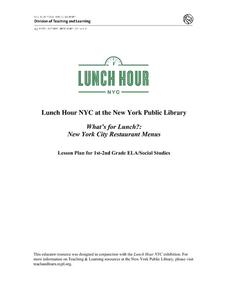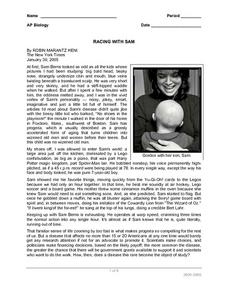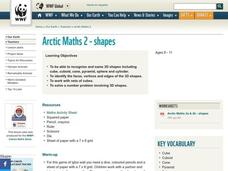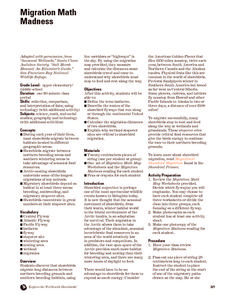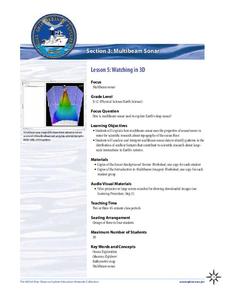PHET
Planet Designer: Kelvin Climb
It's time to get those creative juices flowing! This second instructional activity in a series of five continues allowing pupils to design their own planets. It the same format as the first, but, this time, allows students to alter...
New York Public Library
What's for Lunch?: New York City Restaurant Menus
Do you remember the days when a cup of coffee cost five cents? At A.W. Dennett restaurant in 1894, you could buy a five-cent cup of coffee and as well as a five-cent slice of pie to accompany it. The menu from that year is a primary...
Film English
The Beauty of a Second
Add many seconds of beauty to your class with a short film and related project. The resource centers around a competition based on one-second segments of film, and the final compilation that came from the contest. Pupils identify moments...
Novelinks
The Tempest: Vocabulary Bingo
Bingo! Practice vocabulary from William Shakespeare's The Tempest with a fun matching game. As you call out the definitions, class members mark the new vocabulary words that match and try to get five in a row.
NOAA
Through Robot Eyes
How do robots assist ocean explorers in collecting data and images? The final installment in a five-part series has science scholars examine underwater images collected by robots and identify the organisms shown. Groups then calculate...
DiscoverE
An Egg-Citing Ride
Wheeeee! Young thrill seekers build a bungee jump—not for themselves, though, but for an egg. The egg must fall from a height of five feet and rebound within two inches of the ground or floor.
Curated OER
Assessing Personal Plan of Study for Life-Long Learning
Twelfth graders examine and evaluate their personal education plans and discuss the importance of life-long learning. They discuss personal education plans and goals and reflect on their own plans, complete a Personal Plan of Study...
Curated OER
Practice the 9s
How fast can you finish? Scholars who have already learned multiples of nine get some timed practice as they finish this 60-problem set. They multiply nine by numbers 0-10 with a goal of both speed and accuracy. Two minutes would be an...
Curated OER
Home Reading Log
Ask your learners to keep track of their independent reading progress on a weekly reading log. There is space to write the title of the book, the pages read, a brief summary of what was read each time, and the minutes read. Each of the...
Charleston School District
Review Unit 4: Linear Functions
It's time to show what they know! An assessment review concludes a five-part series about linear functions. It covers all concepts featured throughout the unit, including linear equations, graphs, tables, and problem solving.
Curated OER
Inglés Básico: Clothes (Ropa)
English language learners choose their own pace with this online resource. The website is written primarily in Spanish, and this instructional activity focuses on clothing vocabulary and using present tense and continuous present tense...
Curated OER
Racing with Sam
This assignment begins with an 8-page article about Sam Berns, a young man who suffers the rare genetic disease called progeria. Progeria is caused by a gene mutation and manifests itself as rapid premature aging. When your biology class...
Curated OER
Finding Meaning in the Badge
Children who are three to five years old study two rank badges from the Qing dynasty to develop an understanding of social rank, language skills, and symbolism. The lesson is discussion-based and requires learners to compare and contrast...
Curated OER
Introduction to Age of Absolutism
Who were the absolute monarchs of Europe and what effect did they have on their countries? Young historians begin by naming qualities they believe are important for a monarch to possess. They then take notes on four key factors leading...
Class Antics
Leap Year
What is a Leap Year and why do we have it? Find out with this Leap Day/Leap Year response to reading worksheet in which scholars read a short passage and use their new-found knowledge to answer five questions with short answers.
Chicago Botanic Garden
Review and Assessment: Causes and Effects of Climate Changes
The last activity in the series of five is a short one where individuals show what they've learned about the causes and effects of climate change. Working independently, they fill in a graphic organizer, then compare their notes with a...
Curated OER
Antonyms 2
Delve deeper into word meaning by exploring a word's antonyms. For each of the 10 words listed, high schoolers must identify the correct antonym from a list of five options. Example words include boon, rapt, laggard, and imperceptible....
World Wildlife Fund
Shapes
Investigate the properties of three-dimensional figures with this Arctic-themed math activity. Beginning with a class discussion about different types of solid figures present in the classroom, young mathematicians are then given a...
Curated OER
Who Am I?
Students classify organisms into one of five categories: producer, consumer, decomposer, predator, or prey. Students play a "Who Am I" game. Signs are hung on the backs of fellow students They must ask questions to determine what...
Curated OER
The Last Word: Using Critical Thinking and Analysis to Reach a Decision
Want to explore the process of writing a persuasive essay and tie it in with the upcoming elections? Class members use Venn diagrams and the hamburger model of persuasive writing to write a five-paragraph essay on elections and...
Prince William Network
Migration Math Madness
A great way to incorporate math into life science, this lesson has learners measure migratory routes on a map and calculate the actual distance that shorebirds on the routes would cover. Learners compute the distance covered in both...
NOAA
Graphing Temperatures
Battle of the hemispheres? In the fourth installment of a five-part series, young oceanographers use the NOAA website to collect temperature data from drifters (buoys), one in the Northern Hemisphere and one in the Southern Hemisphere....
NOAA
Wet Maps
How do oceanographers make maps under water? Junior explorers discover the technologies and processes involved in creating bathymetric maps in part three of a five-part series designed for fifth- and sixth-grade pupils. The lesson...
NOAA
Watching in 3D
Bring the ocean floor to life! Earth science scholars discover the process of deep sea mapping in the third installment in a series of five lessons about ocean exploration. The teacher's guide includes helpful resources, worksheets, and...



